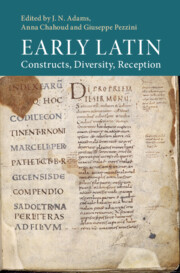Book contents
- Early Latin
- Early Latin
- Copyright page
- Dedication
- Contents
- Illustrations
- Tables
- Contributors
- Acknowledgements
- Abbreviations
- Chapter 1 Introduction: What Is ‘Early Latin’?
- Part I The Epigraphic Material
- Chapter 2 Alphabet, Epigraphy and Literacy in Central Italy in the 7th to 5th Centuries bc
- Chapter 3 Identifying Latin in Early Inscriptions
- Chapter 4 The Egadi Rostra
- Part II Drama
- Part III Other Genres and Fragmentary Authors
- Part IV Reception
- Bibliography
- Index Verborum
- Index of Non-Latin Words
- Index Locorum Potiorum
- Subject Index
Chapter 4 - The Egadi Rostra
A Linguistic Analysis
from Part I - The Epigraphic Material
Published online by Cambridge University Press: 27 July 2023
- Early Latin
- Early Latin
- Copyright page
- Dedication
- Contents
- Illustrations
- Tables
- Contributors
- Acknowledgements
- Abbreviations
- Chapter 1 Introduction: What Is ‘Early Latin’?
- Part I The Epigraphic Material
- Chapter 2 Alphabet, Epigraphy and Literacy in Central Italy in the 7th to 5th Centuries bc
- Chapter 3 Identifying Latin in Early Inscriptions
- Chapter 4 The Egadi Rostra
- Part II Drama
- Part III Other Genres and Fragmentary Authors
- Part IV Reception
- Bibliography
- Index Verborum
- Index of Non-Latin Words
- Index Locorum Potiorum
- Subject Index
Summary
The discovery of eleven bronze rams belonging to war-ships off western Sicily, near the Egadi Islands, has produced an invaluable addition to our record of 3rd century BC Latin inscriptions. The archaeological and historical background as well as the palaeography and language of the Latin texts have been examined by J. Prag in three exemplary discussions (2014; 2017), which are expanded in this chapter. The question informing the present inquiry is whether these texts contribute to our knowledge of early Latin, or merely confirm what we know already about early pronunciation, morphology or syntax. The answer is not simple. Palaeographically and orthographically, the texts are very much in line with what one might expect of inscriptions of that time period. The many abbreviations mean that we cannot say much about their morphology. In principle, we should be able to say more about their pronunciation; but again, results are inconclusive. The texts are neither excessively archaic in appearance, nor excessively modern, and already at this early stage it is difficult to deduce pronunciation from orthography. But that in itself is a worthwhile result.
- Type
- Chapter
- Information
- Early LatinConstructs, Diversity, Reception, pp. 63 - 76Publisher: Cambridge University PressPrint publication year: 2023
- 1
- Cited by

